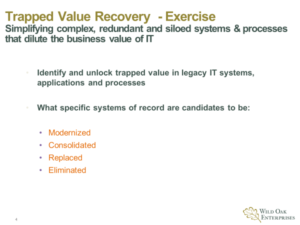
March 17, 2021
In the digital world,
complexity is the enemy of agility and execution

Is complexity holding your operating performance hostage?
As companies race to adopt new cloud computing technologies and systems to effectively compete as digital enterprises, they quickly discover that with new systems, applications and processes comes monumental new complexity.
At a fundamental level, legacy systems of record, which are critical to running core operating functions, like Finance, ERP, CRM and HR were not designed to seamlessly connect with key systems of engagement or systems of intelligence used to create sustainable customer experiences.
At a practical level, developing and deploying new systems of engagement and systems of intelligence requires very different skills and capabilities than maintaining systems of record.
Taken together these two levels of complexity if not dealt with properly can bring a company’s operating performance to its knees.
The hard dollar costs of complexity

The Hackett Group’s benchmark study on the cost of complexity documented that:
- Companies with higher than average technology complexity spend 25% more than average companies and 58% more than companies with low complexity
- The most significant cost factor is the number of applications per end user
- Companies with high numbers of applications employ 27% more FTE’s than average companies
- World class IT functions support 44% fewer applications per end user than typical companies
- The chart below shows the significant cost variance impact on operating performance between high and low complexity
Hackett Benchmark Data Reveals Elevated Operating Cost in G&A Functions with High Technology Complexity

Significantly reducing technology and process complexity will not only improve your operating performance but can dramatically impact your organization’s agility, adaptability and speed to market.
The root causes of complexity

In addition to documenting the hard dollar costs of complexity, The Hacket Group study also identified the top 10 root causes of technology complexity:
- Lack of standards or adherence to standards
- Outdated, inadequate technology/data architecture
- Business cases that fail to identify compatability issues, redundancies or other conflicts
- Mergers and acquisitions without systems consolidation or integration
- Rapid growth
- Lack of system sunsetting or asset management program
- Deferred maintenance, updates, upgrades
- Rampant customizations to applications
- Poor data governance
- Shadow IT
Deploying a Trapped Value Recovery program to reduce complexity

Over the past five years, I have worked with CIOs and other C-Suite executives to reduce complexity by deploying our trapped value recovery program shown on the slide below. The goal of this program is to recover scarce resources, budget, and capacity by identifying legacy systems and processes that can be either modernized, consolidated, replaced, or eliminated. When done fully and effectively, it significantly reduces the complexity of all the processes and systems of record needed to operate the company.

Companies that want to compete as digital enterprises need to operate at the speed of change. Any level of complexity will slow that speed down and compromise your organization’s ability to outperform your competition. Being able to reduce complexity and increase agility is fast becoming the new standard of operating excellence.
As always, I am interested in your comments, feedback and perspectives on the ideas put forth in this blog. Please e-mail them to me at here. And, if this content could be useful to someone you know please share it here:


